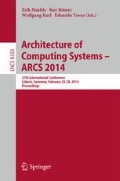Abstract
This article describes a new approach to urban traffic flow sensing using decentralized traffic state estimation. Traffic sensor data is generated both by fixed traffic flow sensor nodes and by probe vehicles equipped with a short range transceiver. The data generated by these sensors is sent to a local coordinator node, that poses the problem of estimating the local state of traffic as a mixed integer linear program (MILP). The resulting optimization program is then solved by the nodes in a distributed manner, using branch-and-bound methods. An optimal amount of noise is then added to the maps before dissemination to a central database. Unlike existing probe-based traffic monitoring systems, this system does not transmit user generated location tracks nor any user presence information to a centralized server, effectively preventing privacy attacks. A simulation of the system performance on computer-generated traffic data shows that the system can be implemented with currently available technology.
Access this chapter
Tax calculation will be finalised at checkout
Purchases are for personal use only
Preview
Unable to display preview. Download preview PDF.
References
Alonso, J., Schmidt, H., Alexandrov, V.N.: Parallel branch and bound algorithms for integer and mixed integer linear programming problems under PVM. In: Bubak, M., Waśniewski, J., Dongarra, J. (eds.) PVM/MPI 1997. LNCS, vol. 1332, pp. 313–320. Springer, Heidelberg (1997)
Aubin, J.-P.: Viability Theory. Systems and Control: Foundations and Applications. Birkhäuser, Boston (1991)
Aubin, J.-P., Bayen, A.M., Saint-Pierre, P.: Dirichlet problems for some Hamilton-Jacobi equations with inequality constraints. SIAM Journal on Control and Optimization 47(5), 2348–2380 (2008)
Barron, E.N., Jensen, R.: Semicontinuous viscosity solutions for Hamilton-Jacobi equations with convex Hamiltonians. Communications in Partial Differential Equations 15, 1713–1742 (1990)
Biswas, S., Tatchikou, R., Dion, F.: Vehicle-to-vehicle wireless communication protocols for enhancing highway traffic safety. IEEE Communications Magazine 44(1), 74–82 (2006)
Canepa, E.S., Claudel, C.G.: Exact solutions to traffic density estimation problems involving the LWR traffic flow model using MILPs. In: Proceedings of the 15th IEEE ITSC Conference, Anchorage, AK (September 2012)
Canepa, E.S., Claudel, C.G.: Spoofing Cyber Attack Detection in Probe-based Traffic Monitoring Systems using MILP. In: Proceedings of IEEE ICNC , San Diego, CA (January 2013)
Claudel, C.G., Bayen, A.M.: Lax-Hopf based incorporation of internal boundary conditions into Hamilton-Jacobi equation. Part I: theory. IEEE Transactions on Automatic Control 55(5), 1142–1157 (2010), doi:10.1109/TAC.2010.2041976.
Claudel, C.G., Bayen, A.M.: Lax-Hopf based incorporation of internal boundary conditions into Hamilton-Jacobi equation. Part II: Computational methods. IEEE Transactions on Automatic Control 55(5), 1158–1174 (2010), doi:10.1109/TAC.2010.2045439.
Claudel, C.G., Bayen, A.: Convex formulations of data assimilation problems for a class of Hamilton-Jacobi equations. SIAM Journal on Control and Optimization 49, 383–402 (2011)
Claudel, C.G., Chamoin, T., Bayen, A.M.: Solutions to estimation problems for Hamilton-Jacobi equations using Linear Programming. In: Submitted to IEEE Transactions on Control Sytems Technology (2010)
Daganzo, C.F.: A variational formulation of kinematic waves: basic theory and complex boundary conditions. Transporation Research B 39B(2), 187–196 (2005)
Frankowska, H.: Lower semicontinuous solutions of Hamilton-Jacobi-Bellman equations. SIAM Journal of Control and Optimization 31(1), 257–272 (1993)
Gruteser, M., Grunwald, D.: Anonymous usage of location-based services through spatial and temporal cloaking. In: Proceedings of the 1st International Conference on Mobile Systems, Applications and Services, pp. 31–42. ACM (2003)
Hoh, B., Gruteser, M., Herring, R., Ban, J., Work, D., Herrera, J.C., Bayen, A.M., Annavaram, M., Jacobson, Q.: Virtual trip lines for distributed privacy-preserving traffic monitoring. In: MobiSys 2008, Breckenridge, CO (2008) (to appear)
Kitakami, H., Hara, H., Yamanaka, H., Miyazaki, T.: Performance evaluation for parallel mixed-integer linear programming system. Optimization Methods and Software 3(4), 257–272 (1994)
Krumm, J.: Inference attacks on location tracks. In: LaMarca, A., Langheinrich, M., Truong, K.N. (eds.) Pervasive 2007. LNCS, vol. 4480, pp. 127–143. Springer, Heidelberg (2007)
Krumm, J.: A survey of computational location privacy. Personal and Ubiquitous Computing 13(6), 391–399 (2009)
Le Ny, J., Pappas, G.: Privacy-preserving release of aggregate dynamic models. In: Proceedings of the 2nd ACM International Conference on High Confidence Networked Systems, pp. 49–56. ACM (2013)
Lighthill, M.J., Whitham, G.B.: On kinematic waves. II. A theory of traffic flow on long crowded roads. Proceedings of the Royal Society of London 229(1178), 317–345 (1956)
Peddinti, S.T., Saxena, N., Birmingham, A.L.: On the limitations of query obfuscation techniques for location privacy. In: International Conference on Ubiquitous Computing (2011)
Work, D., Blandin, S., Tossavainen, O., Piccoli, B., Bayen, A.: A distributed highway velocity model for traffic state reconstruction. Applied Research Mathematics eXpress (ARMX) 1, 1–35 (2010)
Author information
Authors and Affiliations
Editor information
Editors and Affiliations
Rights and permissions
Copyright information
© 2014 Springer International Publishing Switzerland
About this paper
Cite this paper
Canepa, E., Odat, E., Dehwah, A., Mousa, M., Jiang, J., Claudel, C. (2014). A Sensor Network Architecture for Urban Traffic State Estimation with Mixed Eulerian/Lagrangian Sensing Based on Distributed Computing. In: Maehle, E., Römer, K., Karl, W., Tovar, E. (eds) Architecture of Computing Systems – ARCS 2014. ARCS 2014. Lecture Notes in Computer Science, vol 8350. Springer, Cham. https://doi.org/10.1007/978-3-319-04891-8_13
Download citation
DOI: https://doi.org/10.1007/978-3-319-04891-8_13
Publisher Name: Springer, Cham
Print ISBN: 978-3-319-04890-1
Online ISBN: 978-3-319-04891-8
eBook Packages: Computer ScienceComputer Science (R0)

